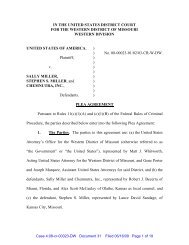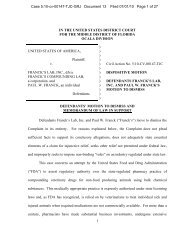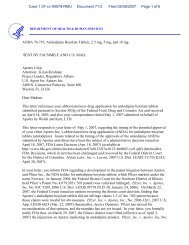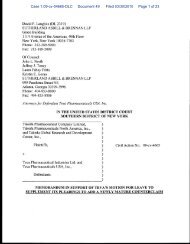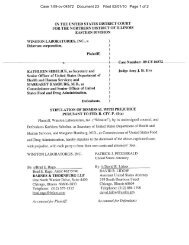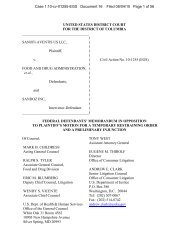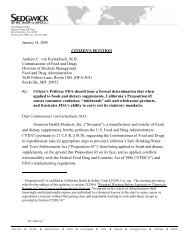first edition (1980) of the Orange Book - FDA Law Blog
first edition (1980) of the Orange Book - FDA Law Blog
first edition (1980) of the Orange Book - FDA Law Blog
You also want an ePaper? Increase the reach of your titles
YUMPU automatically turns print PDFs into web optimized ePapers that Google loves.
posi tive evidence <strong>of</strong> bioavailabili ty is necessary, are shavn to be bioequivalentto an awropriate standard. The agency believes this policy iscoosistent with <strong>the</strong> prevailing opinioo <strong>of</strong> experts and with general experiencein <strong>the</strong> marketplace through <strong>the</strong> years.The agency has coosidered, and rejected, <strong>the</strong> optioo <strong>of</strong> requiringin vivo bioavailabili ty stu::Hes for every product. Such a policy v.ouldresul t in <strong>the</strong> testing in hunans <strong>of</strong> a large number <strong>of</strong> products for which<strong>the</strong>re is 00 evidence <strong>of</strong> a bioavailabili ty problem, and \',()uld <strong>the</strong>reby waste<strong>the</strong> nation's clinical research resources 00 <strong>the</strong> repeti ti ve testing <strong>of</strong> drugproducts for little or 00 scientific purpose. For this reason, <strong>FDA</strong> haselected under its bioavailability and bioequivalence regulations to confinein vivo testing <strong>of</strong> products for bioavailabili ty to those particular drugsror~ich such testing is scientifically and medically necessary. Incoosidering <strong>the</strong> <strong>the</strong>rapeutic equivalence <strong>of</strong> drugs with known or potentialbioavailability problems, <strong>the</strong> agency has followed a policy <strong>of</strong> evaluating as<strong>the</strong>rapeutic equivalents rnly those products that have met current requirements(in vivo testing in hunans, in vitro dissolutioo rate requirements, orboth, aepending 00 <strong>the</strong> drug). -When bioavailability or bioequivalencerequirements are newly established, <strong>the</strong>re is a transitioo period duringwhich all manufacturers are required to sul:rni t informatioo regarding <strong>the</strong>irproducts. For this reasoo sane manufacturers whose products may not haveyet met <strong>the</strong> requirement are still legally marketed.The agency has excluded from <strong>the</strong> List those products that are knavn tobe 00 looger marketed. Approved products row regarded as medical devices,biologics, or foods are also excluded from <strong>the</strong> List. In addition, approveddrug products solely marketed abroad are excluded.D. I.EX;AL STA'IUS OF THE LISTThe Approved Prescriptioo Drug Products list contains only publicinformatioo and advice. The List is not a recomnendatioo as to which drugproducts persoos should purchase, prescribe, dispense, or conversely, whichprodocts should be avoided. It dces not impose any requirement or restrictimupcn any person. TO <strong>the</strong> extent that <strong>the</strong> List identifies drug productsapproved for marketing under sectioos 505 and 507 <strong>of</strong> <strong>the</strong> Federal Food, Drug,and Cosmetic Act, it merely sets forth information to which <strong>the</strong> public isentitled under <strong>the</strong> Freecbm <strong>of</strong> Information Act. Exclusion <strong>of</strong> a drug productfrom <strong>the</strong> List



